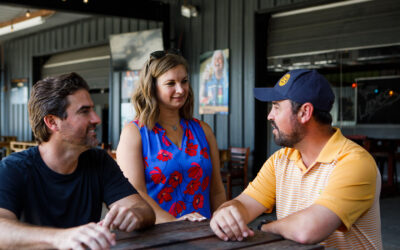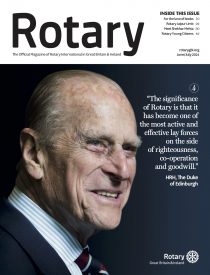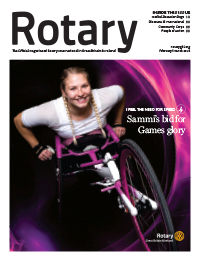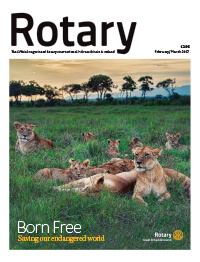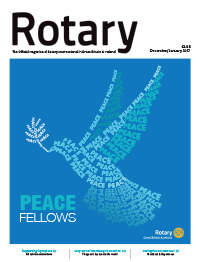Rotary has been facing membership challenges in the UK and Ireland for over a decade. An aging membership base, a varied club experience, and struggles in converting centrally generated prospects into active members at a local level have created a potent mix.
Understandably, the focus of all clubs and members is on delivering service in their communities and not always on recruitment. The reality is, understandably, that most Rotarians don’t join Rotary to grow Rotary.
Listen to this article
As a separate geographic Rotary region in Great Britain and Ireland, we have our own staff team and group of volunteer Rotarian senior leaders who can drive membership efforts centrally.
The need to reduce the burden solely on clubs to grow themselves and address the long-term downward membership trend was clear and in 2019 the idea of direct membership was born.
Put simply, direct members do not belong to a specific club, they belong to Rotary.
Members join an online community using the Microsoft Teams infrastructure, allowing for video calling, instant messaging, drop-in events, and a variety of ‘channels’, organically growing based on the specific interests and activities of members.”
Tim Mason, a Rotarian since 1980, is Great Britain and Ireland’s lead on direct membership and has been instrumental in the project since the beginning.
“Direct membership has made me a global citizen. I’m like a tortoise, I carry my Rotary home with me,” Tim explains.
“I always wanted to be a Rotarian in Rotary International.
“Now I belong to every club in the world. As a community worker joining Rotary in 1980, I have been a member of 14 different clubs, being invited each time, now I’m just a Rotarian. Simple.”
Direct members pay a subscription of £10 per month and receive the same benefits as club members: meaningful connections, access to project opportunities, our magazine, insurance cover – the lot.
Members join an online community using the Microsoft Teams infrastructure, allowing for video calling, instant messaging, drop-in events, and a variety of ‘channels’, organically growing based on the specific interests and activities of members.
Since its launch in 2020, the network has grown to over 300 active, paying members. Some have moved from existing Rotary groups seeking an alternative experience, but most are completely new to Rotary, such as 39-year-old Elizabeth Amoaa.
“I chose direct membership because it suits my lifestyle,” says Elizabeth, who was born in Ghana and now lives in Nottingham.
“I’m not limited to just one club, but instead I’ve joined a busy environment that allows me to connect with Rotarians across the world in various projects.”
Far from being competition to the classic or even flexible club models, direct membership complements it.
The network is now reaching out across our region’s 24 districts to better connect direct members with those on the ground and give them access to a hands-on in-person experience.
The challenge for us is to become the go-to organisation when the time is right.”
While experiencing direct membership, members have three choices; They can maintain direct membership, move to a club in their area, or connect with newly formed districtbased hubs within direct membership.
The latter offers the best of both worlds, with the ability to network and volunteer in person locally while maintaining a place in the direct membership online environment.
Tim says: “For some time now, I’ve believed we can help new start-ups to incubate and grow whilst members become Rotarians and work can happen in the local community without the worry that the magic 20 members necessary to charter is not reached and we lose potential Rotarians.”
This desire for flexibility and episodic volunteering is something that has become fundamental in the UK in recent years and is a need that Rotary hasn’t fully catered to so far.
In 2018, long before the COVID-19 pandemic came into our consciousness, research from the National Council for Voluntary Organisations (NCVO), the UK’s membership body for charities and community entities, found that almost 1 in 4 volunteers did so exclusively on activities they could dip in and out of.
Direct Membership allows individuals to join Rotary as an organisation, meaning you aren’t limited to just one club and can work across multiple projects 🤝
Find out more from Amanda Watkin: https://t.co/bntC62PBXr pic.twitter.com/OfkRSROUSw
— Rotary GB & Ireland (@RotaryGBI) August 22, 2023
Rotary GB&I General Secretary Amanda Watkin’s column on Direct Membership
It also found that flexibility was the number one factor most likely to encourage those who haven’t volunteered before to do so.
Direct membership was a reaction to this growing trend. Giving people access to the power of the Rotary network in a way that could be done remotely, at a time that was convenient and without being tied down.
For all the misery it caused to so many, the pandemic accelerated a technological revolution within Rotary that would have otherwise taken years to achieve.
Five years on from that initial research, with the pandemic hopefully in our rear-view mirror but society fundamentally altered, NCVO’s latest reports show similar findings. Firstly, that people’s primary concern when getting involved with voluntary organisations is a lack of flexibility, and secondly, that remote volunteering is here to stay.
Although it is clearly desirable to retain members for as long as possible, perhaps in Rotary we need to adjust our thinking and be open to the fact that some individuals may come and go as their circumstances and priorities change.
The challenge for us is to become the go-to organisation when the time is right.
Click here to watch Tim Mason and Amanda Watkin have an in-depth conversation on direct membership.










